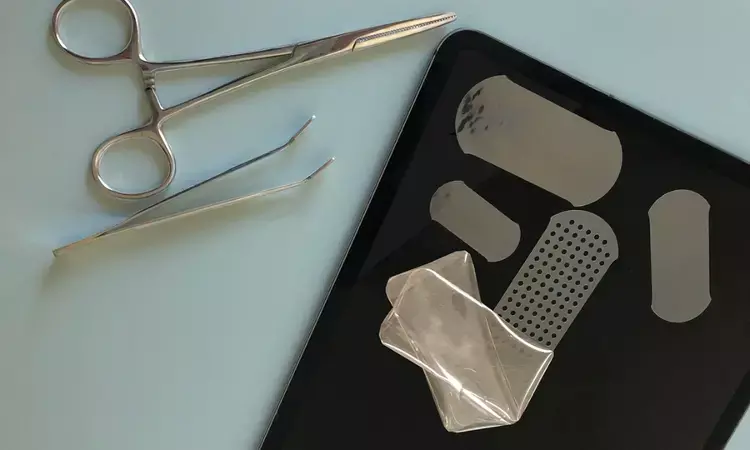- Home
- Medical news & Guidelines
- Anesthesiology
- Cardiology and CTVS
- Critical Care
- Dentistry
- Dermatology
- Diabetes and Endocrinology
- ENT
- Gastroenterology
- Medicine
- Nephrology
- Neurology
- Obstretics-Gynaecology
- Oncology
- Ophthalmology
- Orthopaedics
- Pediatrics-Neonatology
- Psychiatry
- Pulmonology
- Radiology
- Surgery
- Urology
- Laboratory Medicine
- Diet
- Nursing
- Paramedical
- Physiotherapy
- Health news
- Fact Check
- Bone Health Fact Check
- Brain Health Fact Check
- Cancer Related Fact Check
- Child Care Fact Check
- Dental and oral health fact check
- Diabetes and metabolic health fact check
- Diet and Nutrition Fact Check
- Eye and ENT Care Fact Check
- Fitness fact check
- Gut health fact check
- Heart health fact check
- Kidney health fact check
- Medical education fact check
- Men's health fact check
- Respiratory fact check
- Skin and hair care fact check
- Vaccine and Immunization fact check
- Women's health fact check
- AYUSH
- State News
- Andaman and Nicobar Islands
- Andhra Pradesh
- Arunachal Pradesh
- Assam
- Bihar
- Chandigarh
- Chattisgarh
- Dadra and Nagar Haveli
- Daman and Diu
- Delhi
- Goa
- Gujarat
- Haryana
- Himachal Pradesh
- Jammu & Kashmir
- Jharkhand
- Karnataka
- Kerala
- Ladakh
- Lakshadweep
- Madhya Pradesh
- Maharashtra
- Manipur
- Meghalaya
- Mizoram
- Nagaland
- Odisha
- Puducherry
- Punjab
- Rajasthan
- Sikkim
- Tamil Nadu
- Telangana
- Tripura
- Uttar Pradesh
- Uttrakhand
- West Bengal
- Medical Education
- Industry
Short-term wound cosmesis poorer with tissue adhesive in pediatric patients

Short-term wound cosmesis was poorer with tissue adhesive although it is unclear whether this difference is sustained in the long-term suggests a recent study published in the British Journal of Surgery
Tissue adhesive, adhesive tape, and sutures are used to close surgical incisions. However, it is unclear which produces the best results in children, and whether combination wound closure is better than sutures alone.
In this parallel randomised controlled trial (ANZCTR: ACTRN12617000158369), children (aged 18 years or less) undergoing elective general surgical or urological procedures were randomized to skin closure with sutures alone, sutures and adhesive tape, or sutures and tissue adhesive. Participants were assessed 2 weeks, 6 weeks, and more than 6 months after operation. Outcomes included wound cosmesis (clinician- and parent-rated) assessed using four validated scales, parental satisfaction, and wound complication rates.
Results
• 295 patients (333 wounds) were recruited and 277 patients (314 wounds) were included in the analysis.
• Tissue adhesive wounds had poorer cosmesis at 6 weeks: median 10-point VAS score 7.7 with sutures alone, 7.5 with adhesive tape, and 7.0 with tissue adhesive (P = 0.014).
• Respective median scores on a 100-point VAS were 80.0, 77.2, and 73.8 (P = 0.010).
•This difference was not sustained at over 6 months.
• There was no difference in parent-rated wound cosmesis at 6 weeks (P = 0.690) and more than 6 months (P = 0.167): median score 9.0 with sutures alone, 10.0 with adhesive tape, and 10.0 with tissue adhesive at both stages.
• Parental satisfaction was similar at all points, with a median score of 5 (very satisfied) for all groups.
• There was one instance of wound dehiscence in the tissue adhesive group and no wound infections.
Short-term wound cosmesis was poorer with tissue adhesive although it is unclear whether this difference is sustained in the long-term. There were no differences between techniques for the study outcomes.
Reference:
Sarthak Tandon, Nicholas D Ensor, Maurizio Pacilli, Ashleigh J Laird, Juan I Bortagaray, Robert J Stunden, Ramesh M Nataraja, Tissue adhesive, adhesive tape, and sutures for skin closure of paediatric surgical wounds: prospective randomized clinical trial, British Journal of Surgery, Volume 109, Issue 11, November 2022, Pages 1087–1095, https://doi.org/10.1093/bjs/znac254
Dr. Shravani Dali has completed her BDS from Pravara institute of medical sciences, loni. Following which she extensively worked in the healthcare sector for 2+ years. She has been actively involved in writing blogs in field of health and wellness. Currently she is pursuing her Masters of public health-health administration from Tata institute of social sciences. She can be contacted at editorial@medicaldialogues.in.
Dr Kamal Kant Kohli-MBBS, DTCD- a chest specialist with more than 30 years of practice and a flair for writing clinical articles, Dr Kamal Kant Kohli joined Medical Dialogues as a Chief Editor of Medical News. Besides writing articles, as an editor, he proofreads and verifies all the medical content published on Medical Dialogues including those coming from journals, studies,medical conferences,guidelines etc. Email: drkohli@medicaldialogues.in. Contact no. 011-43720751


